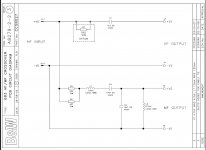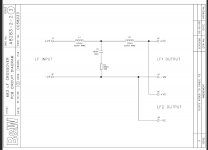Hi All,
I`m hoping someone can explain the roles of the components in these crossover networks in layman's terms. I know that a capacitor in series with a tweeter acts as a simple first order high pass filter and a coil in series with a woofer, a first order low pass filter. Beyond that, it`s a mystery to me.
I would like to understand what is happening in the network that I have attached. These are found in a pair of recently acquired B&W 683s which I`ve been quite pleasantly surprised by and I`m thinking that the simplicity of the crossover network may have something to do with it.
In comparison with some Dynaudio Audience 72SE`s that I had previously which employed far more expensive drivers, I found their overall presentation to be over-equalized, if that makes sense and ultimately less enjoyable to listen to. There is no question they were more refined than the 683s but they didnt do music as well. Their networks are much more complex.
I also experienced something similar with an old pair of second generation B&W 603. They too had minimal crossover components and played music so well.
So far I`m quite happy with the 683s as they are but I do realize they are built to a certain price point, would you think better quality capacitors would make for a cost effective improvement?
Any and all input would be greatly appreciated🙂
I`m hoping someone can explain the roles of the components in these crossover networks in layman's terms. I know that a capacitor in series with a tweeter acts as a simple first order high pass filter and a coil in series with a woofer, a first order low pass filter. Beyond that, it`s a mystery to me.
I would like to understand what is happening in the network that I have attached. These are found in a pair of recently acquired B&W 683s which I`ve been quite pleasantly surprised by and I`m thinking that the simplicity of the crossover network may have something to do with it.
In comparison with some Dynaudio Audience 72SE`s that I had previously which employed far more expensive drivers, I found their overall presentation to be over-equalized, if that makes sense and ultimately less enjoyable to listen to. There is no question they were more refined than the 683s but they didnt do music as well. Their networks are much more complex.
I also experienced something similar with an old pair of second generation B&W 603. They too had minimal crossover components and played music so well.
So far I`m quite happy with the 683s as they are but I do realize they are built to a certain price point, would you think better quality capacitors would make for a cost effective improvement?
Any and all input would be greatly appreciated🙂
Attachments
Are you puzzled by the position of the components in the MF section?
Indeed for a fair reading it should be L1 followed by C2 then C3 followed by L2, so it makes a 2nd order LP and HP.
The voltage rating suggests that film capacitors are employed, and shouldn't be changed.
The 150 uF in the Woofer section is electrolytic and it's ok.
Indeed for a fair reading it should be L1 followed by C2 then C3 followed by L2, so it makes a 2nd order LP and HP.
The voltage rating suggests that film capacitors are employed, and shouldn't be changed.
The 150 uF in the Woofer section is electrolytic and it's ok.
Being out of order, the components make it another electrically second-order crossover in the midband. With such a solution a slightly different transfer function can be achieved, which is why it is usually used in this way.
As for modify, you could try using "better" capacitors, especially before the tweeter. You might hear a difference, but you might not like it better at all.
Did you mean that?
As for modify, you could try using "better" capacitors, especially before the tweeter. You might hear a difference, but you might not like it better at all.
Did you mean that?
I`m hoping someone can explain the roles of the components in these crossover networks in layman's terms. I know that a capacitor in series with a tweeter acts as a simple first order high pass filter and a coil in series with a woofer, a first order low pass filter. Beyond that, it`s a mystery to me.
-Damped 3rd order electrical low-pass on the LF (the resistor in series with the shunt cap provides some damping around the corner frequency).
-2nd order electrical high & low-pass on the MF with padding resistors (presumably two used to improve power-handling).
-1st order electrical high-pass on the HF with an optional padding resistor.
Last edited:
- Status
- Not open for further replies.

